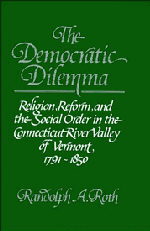 The Democratic Dilemma
The Democratic Dilemma Book contents
- Frontmatter
- Contents
- List of tables and maps
- Acknowledgments
- Introduction
- 1 The revolutionary frontier, 1763–1800
- 2 The failure of the covenanted community and the standing order, 1791–1815
- 3 Religion and reform in the shaping of a new order, 1815–1828
- 4 From an era of promise to pressing times, 1815–1843
- 5 A clamor for reform, 1828–1835
- 6 The great revival, 1827–1843
- 7 A modified order in town life and politics, 1835–1850
- 8 Boosterism, sentiment, free soil, and the preservation of a Christian, reformed republic
- Conclusion: Religion, reform, and the problem of order in the Age of Democratic Revolution
- Appendix A Church records
- Appendix B Types of towns
- Appendix C Occupational groups
- Appendix D Statistical methods
- Notes
- Index
1 - The revolutionary frontier, 1763–1800
Published online by Cambridge University Press: 04 August 2010
- Frontmatter
- Contents
- List of tables and maps
- Acknowledgments
- Introduction
- 1 The revolutionary frontier, 1763–1800
- 2 The failure of the covenanted community and the standing order, 1791–1815
- 3 Religion and reform in the shaping of a new order, 1815–1828
- 4 From an era of promise to pressing times, 1815–1843
- 5 A clamor for reform, 1828–1835
- 6 The great revival, 1827–1843
- 7 A modified order in town life and politics, 1835–1850
- 8 Boosterism, sentiment, free soil, and the preservation of a Christian, reformed republic
- Conclusion: Religion, reform, and the problem of order in the Age of Democratic Revolution
- Appendix A Church records
- Appendix B Types of towns
- Appendix C Occupational groups
- Appendix D Statistical methods
- Notes
- Index
Summary
The first patents for settlement of the Connecticut River Valley of Vermont, which was then a part of what was known as the New Hampshire Grants, were issued by Governor Bennington Wentworth of New Hampshire in 1749. Wentworth claimed title on behalf of his colony to the land that lay west of the Connecticut River and east of Lake Champlain, and by 1764 he had placed three million acres – nearly half the future state of Vermont – into the hands of speculators and prospective settlers. Few people dared come to the valley at first, however, because until 1763 it was little more than a battleground for the English, the French, and their Indian allies. It was not until the Seven Years' War ended that the floodgates opened and thousands of settlers came driving north and west from Connecticut, Massachusetts, and New Hampshire.
The valley remained a violent place for many years. Its proximity to Canada meant that settlers were vulnerable to attack throughout the American Revolution. The worst such attack took place in 1780, when the British and their native allies raided the frontier settlement of Royalton. They killed four men, seized twenty-five prisoners, burned twenty homes, and slaughtered nearly 150 cattle. Similar, if less devastating raids occurred through 1782. Settlers were terrified by these attacks – so much so that when the inhabitants of Athens, a small town in Windham County, heard Indian warwhoops issuing from the woods one day they ran for their lives, leaving Athens a ghost town.
- Type
- Chapter
- Information
- The Democratic DilemmaReligion, Reform, and the Social Order in the Connecticut River Valley of Vermont, 1791–1850, pp. 15 - 40Publisher: Cambridge University PressPrint publication year: 1987


